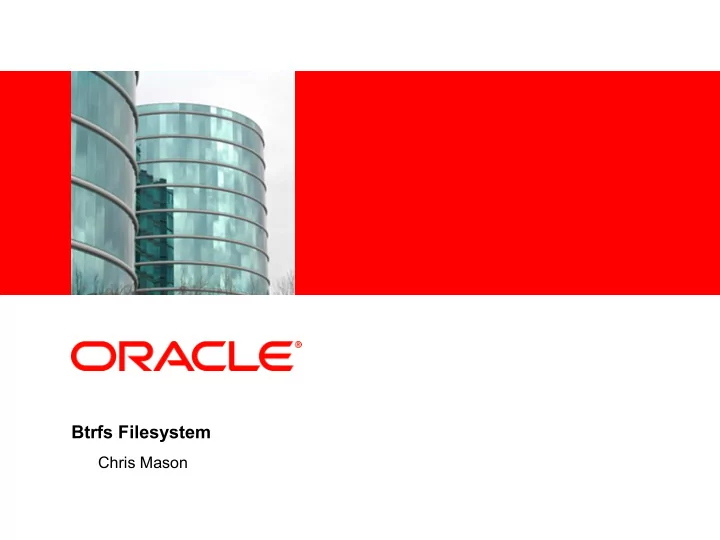

<Insert Picture Here> Btrfs Filesystem Chris Mason
Btrfs Goals • General purpose filesystem that scales to very large storage • Feature focused, providing features other Linux filesystems cannot • Administration focused, easy to run and very fault tolerant • Perform well in a variety of workloads
Btrfs Features • Extent based file storage • Copy on write metadata and data • Space efficient packing of small files • Optional transparent compression (zlib) • Integrity checksumming for data and metadata • Writable snapshots • Online resize, defragmentation, device management • Multiple device support • Offline conversion from Ext3 and Ext4 • Specialized log for fast fsync and O_SYNC writes
Btrfs Status • Included in 2.6.29 • Generally usable in many workloads • Generally stable • No disk format changes planned • Development team includes many companies and individuals • Proper ENOSPC handling • AIO/DIO support • Snapshot assisted upgrades
Btrfs Btree • Generic key/value pair storage • The same btree core used for all metadata • Protected by copy on write for crash safety • Transaction id stored in block headers and pointers – Allows efficient searches for recent changes • Metadata from different files and directories is mixed together in a block • All metadata is addressed by a key and searched for in the btree • Key order keeps related items close together in the btree
Snapshots and Subvolumes • Subvolume is the unit of snapshotting – Individual files may be cloned without a full snapshot – Cloning support now in cp --relink • Subvolumes may be created anywhere in the directory tree • Reference counts and back references track every extent and btree block • Snapshots can be written and snapshotted again • Snapshots not suitable for continuous data protection
Multi-device Support • Devices are added into a pool of available storage • New logical address space is allocated with a specific RAID configuration and data storage flags – System (used by the volume management code) – Metadata – Data – Raid0, raid1, raid10, single-spindle-dup – RAID5,6 are coming • Space is allocated from the storage pool in large chunks (1GB or more) • Devices can be mixed in size and speed
Thin Provisioning • Btrfs storage chunks are well suited to thin provisioning • Btrfs can return large chunks of storage back to the array • Btrfs can quickly expand the FS • Discard support in Btrfs sends information about unused blocks down to the storage at run time
Synchronous Operations • COW transaction subsystem is slow for frequent commits – Forces recow of many blocks – Forces significant amounts of IO writing out extent allocation metadata • Write ahead log added for synchronous operations on files or directories • File or directory items are copied into a dedicated tree – File back refs allow us to log file names without the directory – One log btree per subvolume
Synchronous Operations • The log tree uses the same COW btree code as the rest of the FS • The log tree uses the same writeback code as the rest of the FS, and uses the metadata raid policy. • Commits of the log tree are separate from commits in the main transaction code. – fsync(file) only writes metadata for that one file – fsync(file) does not trigger writeback of any other data blocks
Hot / Cold Extent Migration • Patches contributed by IBM • Track extents used most often • Migrate to and from fast devices • Uses existing COW infrastructure to trigger migration
Pending Projects (Short) • Dedicated metadata/data drives – Required disk format changes already in place • Readonly snapshots • Per file / directory controls for datacow, compression • Chunk tree backups • Rsync integration with file modification tracking • Atomic write API • Backref walking utilities • Scrubbing utilities • Discard (trim) utilities • Benchmarking
Pending Projects (Long) • Dedup • Track IO errors on a per device basis • Random write performance tuning • Front end caching SSDs • Online semantic fsck • Free inode number cache • Snapshot aware file defragmentation • Btree lock contention • Benchmarking
Conclusions • http://btrfs.wiki.kernel.org/ • chris.mason@oracle.com
Recommend
More recommend